This feijoa fizz is a simple way use left over feijoa skins to get maximum flavor from them. A quick homebrew that makes a delicious fizzy alcoholic drink.

Jump to:
What do you do when its feijoa season, you've been baking up a storm, perhaps a batch of feijoa muffins or feijoa loaf, but have heaps of feijoa skins left over? You could try making my feijoa syrup or for something fun and delicious this easy alcoholic feijoa fizz.
When I first tried making this homemade soda I was skeptical. How could feijoa skins with a little sugar produce a tasty and fizzy drink without manually carbonating it? It is really that easy to make what is essentially a mild feijoa cider at home, with hardly any equipment? Yes, yes it is.
This feijoa drink is incredibly easy to make, its delicious and really fizzy! It uses the natural yeast present in the feijoa skins to form a quick fermentation, enhancing the natural flavor of the feijoa skins and giving this drink a wonderful fizzy tang.
Of course if you're not confident in natural yeast in your feijoa skins you can also add the tiniest amount of champagne or wine yeast which will ensure you're fizz is extra fizzy and boost the alcohol content.
This feijoa fizz is basically a quick homebrew, similar to a ginger beer or cider. Its brewed over two stages, the initial fermentation with the skins, then strained off and bottled for a second fermentation.
It will contain at least some alcohol so this feijoa drink is not suitable for children. The exact amount of alcohol in the final product with depend on a number of things, the sweetness of the feijoas, how much natural yeast they have on them, the amount of sugar you add, if you add extra yeast and the temperature of the initial and second fermentation. All of this means it can be really hard to tell exactly how much alcohol is in your final fizz. Its likely to be about 2 - 3% but could be as little as .5% or as much as 8%. If you wanted to find out exactly you can check this relatively easily using a hydrometer or refractometer.
For maximum safety do not give this fizz to children and always assume it could contain a reasonable amount of alcohol and therefore treat it will the same level of caution you would with any other alcoholic drink.
Looking for more tasty feijoa recipes? Check out my full collection of feijoa recipes including everything from chutney and muffins to crumble and cake and even jam!
Ingredients

Feijoa skins: this recipe uses feijoa skins that have already had the flesh scooped out of them. I used about three tightly packed cups of skins, or 750gms. If you don't have enough left over skins from another recipe you can half the recipe, or freeze the skins and top them up until you have enough.
Sugar: a little white sugar helps feed the yeast in skins and boosts the fermenting process.
Water: an essential ingredient to make this syrup. Regular tap water is fine, provided it drinkable where you are.
Wine or champagne yeast (optional): a little champange or wine yeast will enhance the natural bubbles of this fizz and help boost the natural yeasts in the skins. You can leave it out if you prefer.
How to make feijoa fizz
First check to make sure there are no moldy or bad bits on your feijoa skins. Cut off and discard these. There is no need to remove the flower tip. Do Not wash the skins as you will wash off the wild yeast you need to ferment the fizz.
Find a large deep container that you can clean and ideally sterilize properly, that will fit in all your feijoa skins. I like to use a large glass jar I found. Make sure your container is properly clean, dry and ideally sterilized.

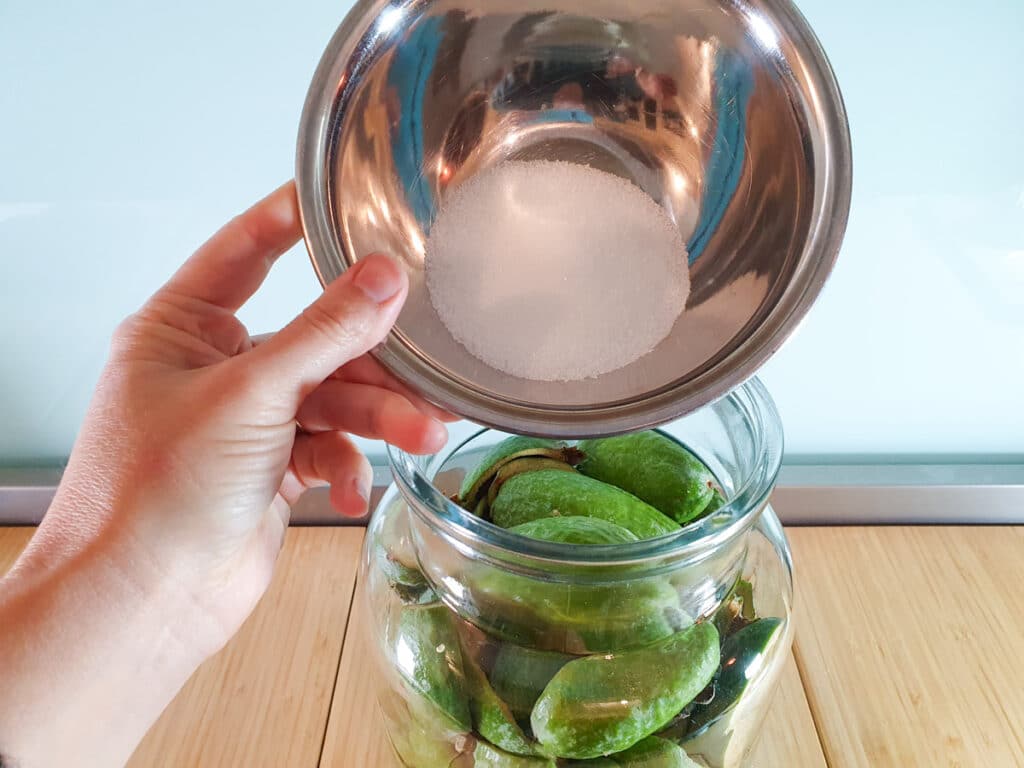
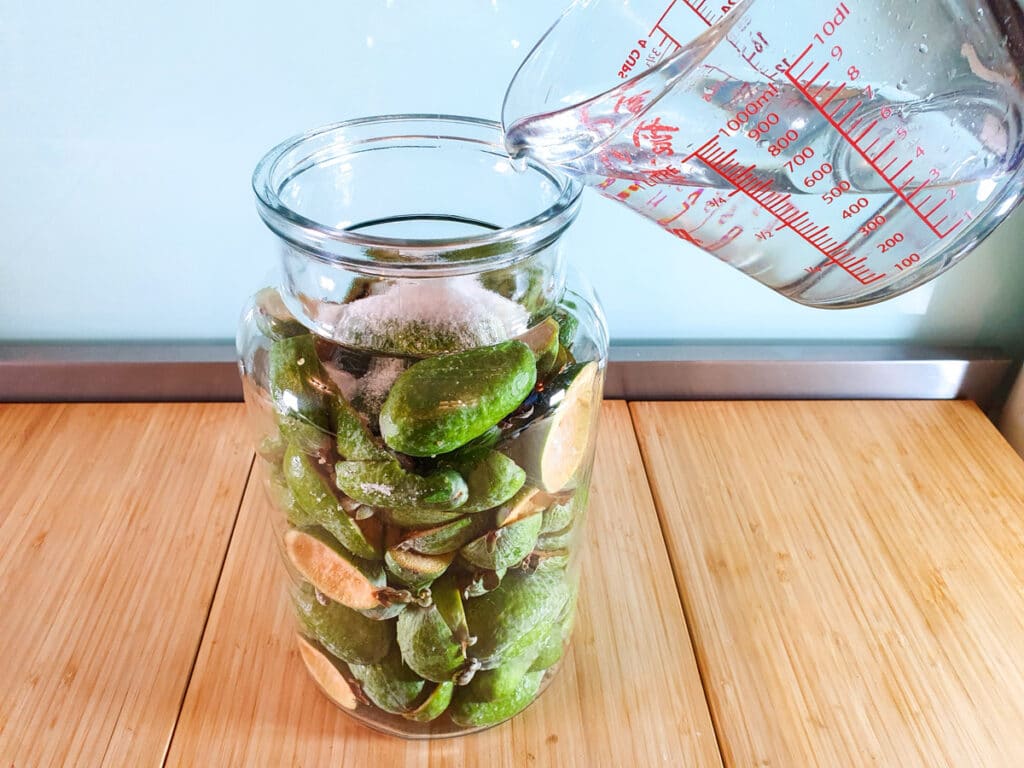

Put in your feijoa skins into a container that's large enough to fit all the feijoa skins covered in water. Try to pack them in a bit so they stay together. Sprinkle over the sugar and top up with water until all the feijoa skins are submerged. Some of the feijoa skins may start to float so its important to weight them down with something. This can be as simple as a glass, plate or bowl but must be properly clean and dry before using.

Cover the container loosely with cling film or a tea towel and leave in a cool, dry place for three to five days.
Its important to watch your fermenting feijoa skins carefully. If some of the skins float to the top you will need to try and submerge them again.
Hot tip: you will need to watch your fermenting skins carefully. If they start showing any signs of mold you will need to discard the lot and start again. The main reason the skins can go bad is if some of the feijoa skins have floated up and are poking out of the water at the top, so try to make sure they are all well submerged and weighted down.
The mix will start to go cloudy when its done and may start to bubble. This is the natural fermentation and fizziness starting. If the water is still looking very clear you can leave it for a further one to three days. Once the skins have done their first fermentation, strain the liquid into a large bowl or container and discard the skins.
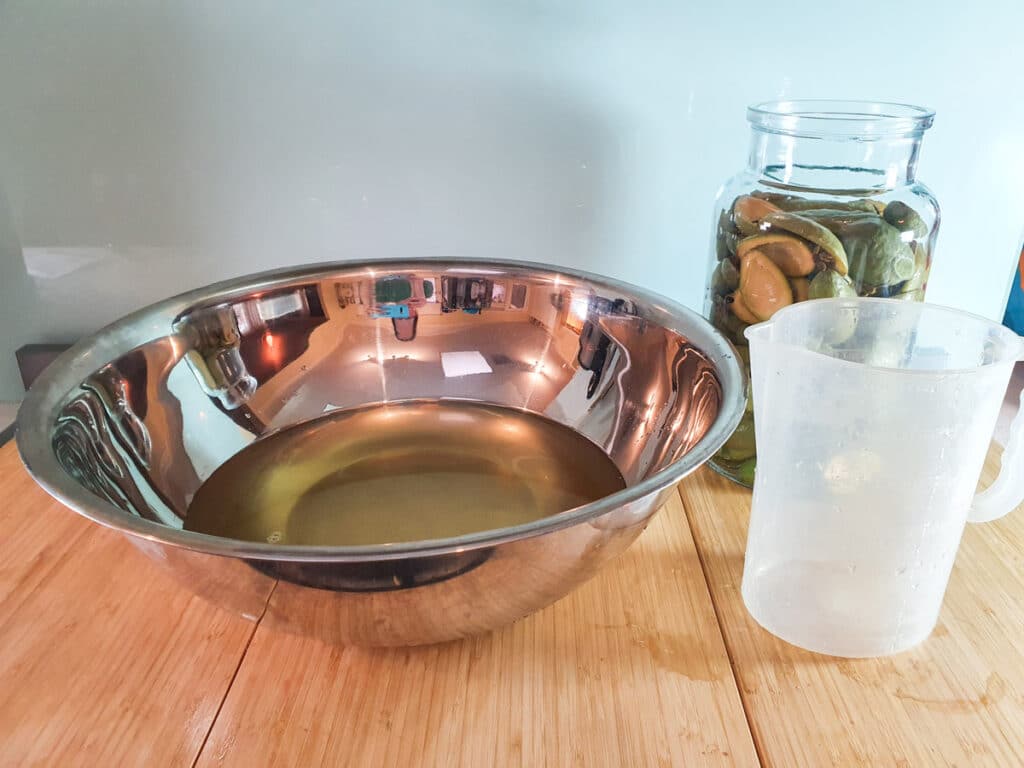
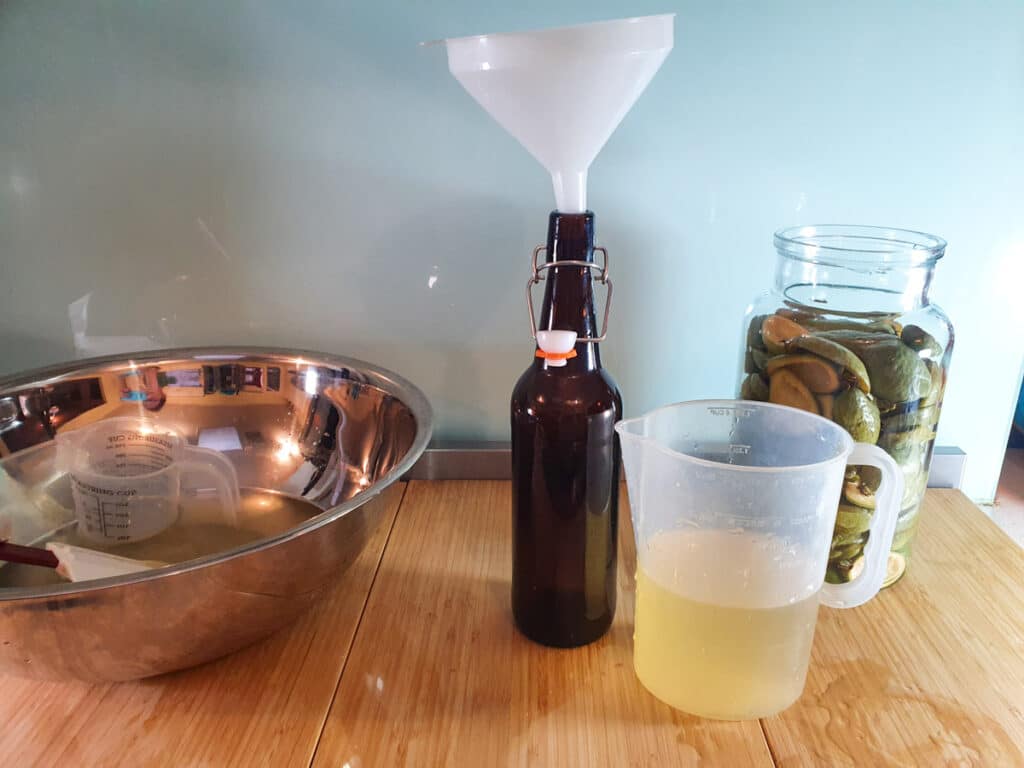
Mix in the extra sugar and the wine yeast if using. Pour into pressure proof bottles. This is easiest with a funnel or you can use a jug with a spout and pour carefully. You can get proper pressure rated brewing bottles like I have used here but you can also you a clean soft drink bottle.

Put the lid own firmly and tut the bottles into a cool, dry place for another two to three days. The bottle should be visibly starting to bubble around the edge of the liquid. You can chill it in the fridge at this point if you like or serve at room temperature.
Carefully remove the lid, being mindful of the fact a considerable amount of pressure may have built up. If your fizz is looking particularly bubbly I recommend using gloves, covering the lid with a tea towel and opening carefully over the sink or a large bowl. You may need to crack the lid a little to release the pressure, then hold mostly it closed while its bubbling to release the pressure without letting all your fizz bubble out.
How to serve
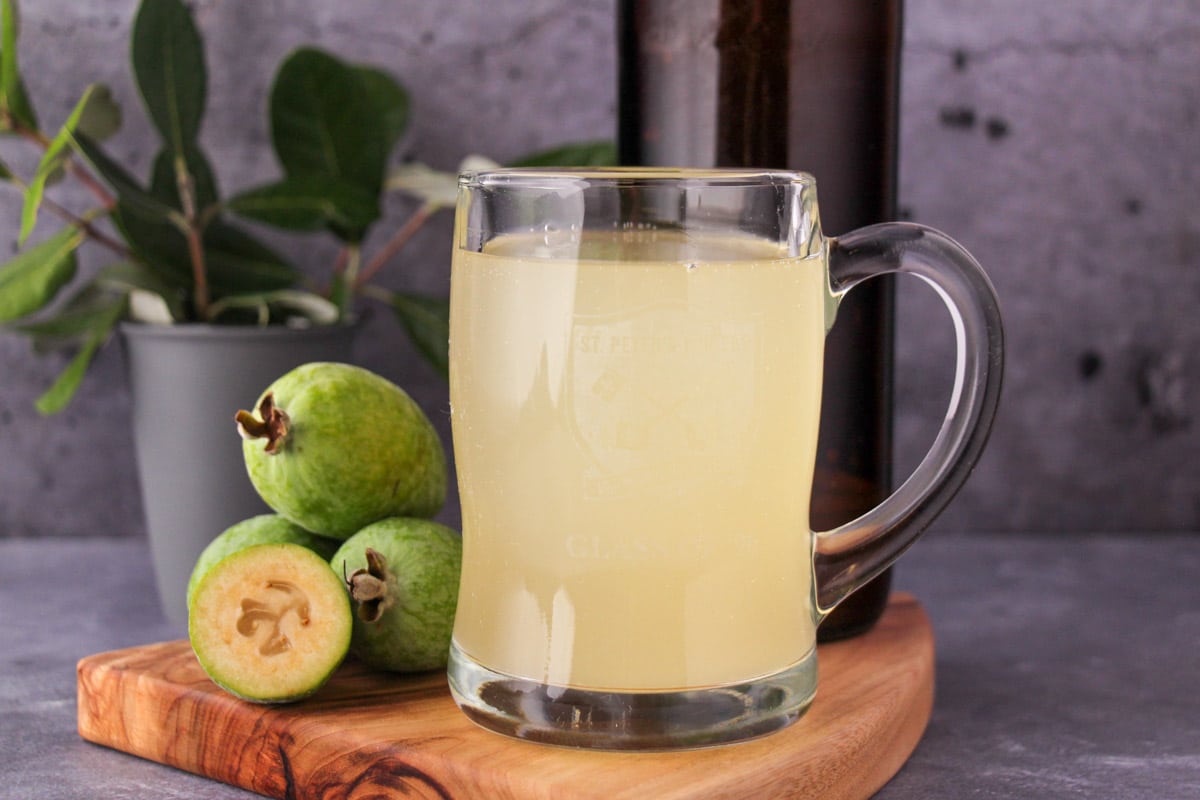
Pour into glasses, trying to avoid the last bit of sediment at the bottom and drink immediately for maximum fizz.
How to store
If you leave the fizz in the bottles after the second fermentation it will continue to ferment and become more alcoholic. If not drinking immediately I recommend storing in the fridge for up to two days. Beyond this I find its not drinkable straight away and will need to be aged to make it nicer to drink again, which is a whole different ball game and more akin to making traditional cider.
Have you made this recipe? Tell me how it went in the comments below!
Looking for more yummy recipes?
Why not try making
Follow me on Facebook for many more delicious recipes.
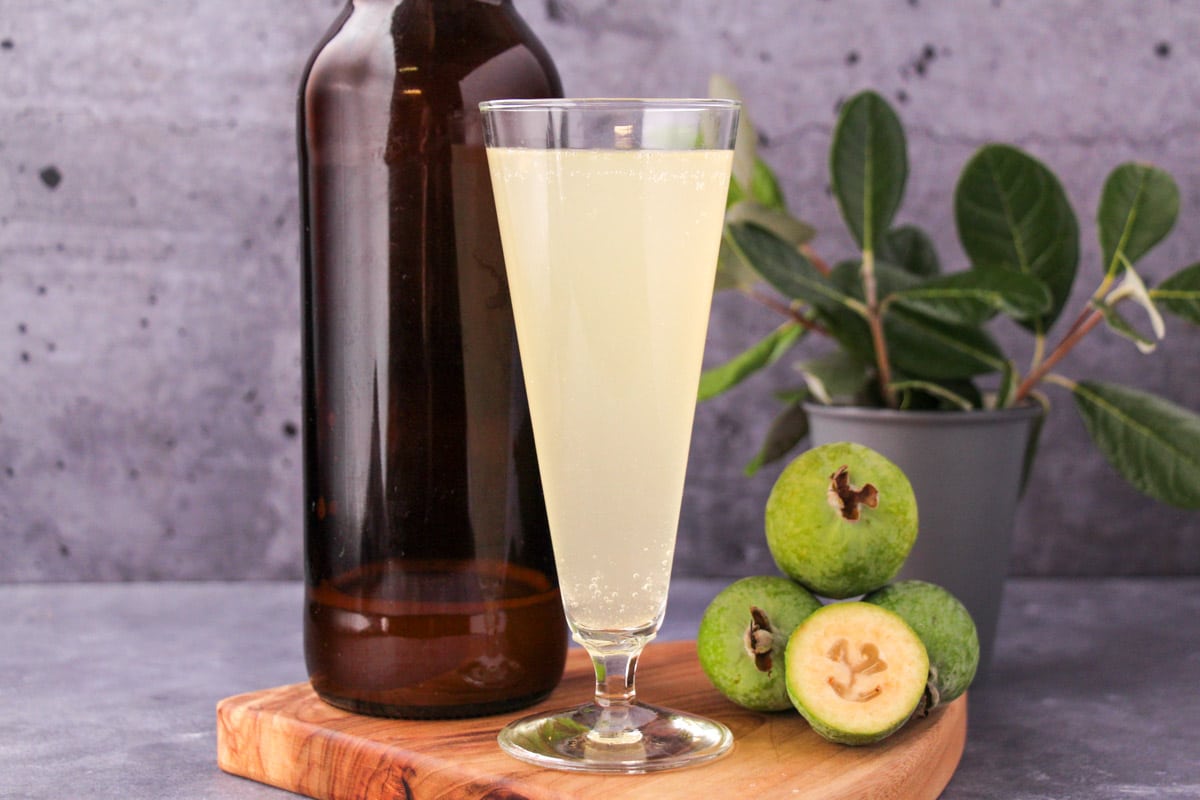
📖 Recipe
Feijoa fizz
Equipment
- A 3 - 4 liter container or jar, or large enough to put all your feijoa skins in and cover with water.
- Something to weigh down the feijoa skins in the jar, such as a glass, plate or bowl.
- Pressure proof bottle such as clean soft drink bottle or pressure rated brewing bottles.
- Funnel or jug with a spout.
- Optional - digital kitchen scales to accurately measure sugar and yeast.
- Optional - hydrometer or refractometer to measure the alcohol content of the final fizz.
Ingredients
For first ferment
- several cups feijoa skins
- 2 - 3 liters (8 - 12 cups) water, or enough to full cover the feijoa skins
- ¼ cup (55gms) white sugar
For second ferment
- 18 gms white sugar (or 8 gms per liter of strained first ferment)
- 1 gram champagne or wine yeast per 4 liters of first ferment, or as per packet instructions (optional)
Instructions
- Make sure your container is clean, dry and ideally sterile before starting.
- Fill your jar with feijoa skins. Try to pack them down within the jar so they are nice and firm. Sprinkle with sugar and top with water until all your feijoa skins are completely covered.
- Some of the not packed in feijoa skins can start to float. The challenge is to find something that you can clean properly that you can use in your jar to weigh down the skins. If you have filled a jar which narrows at the top you use something like a glass, then put more water In the glass to weigh it down more.
- Cover lightly with cling film or a tea towel. Leave to warm, dry place, such the kitchen or laundry bench for two to three days or until the water starts to turn cloudy and may start bubbling. If the water is still clear you can leave it for another one to three days.
- NB Watch your skins carefully. If they are showing any signs of mold (usually little black and grey specks of filaments around the edge) you will unfortunately need to discard the whole batch and start again. The main cause of this is skins stick up out of the water, so its important to make sure they are well weighed down.
- Tip the first fermented water into a large bowl and strain off all the feijoa skins.
- Add the extra sugar and wine yeast if using and mix well.
- Pour into clean pressure proof bottle and leave in a warm dry place for another two to three days.
- Optional: chill in fridge for a few hours or serve at room temperature.
- CAUTION: the pressure may have build up considerably in the bottles by this point, especially if added the extra wine yeast. You can get an idea of this by how bubbly it is around the top of the liquid in the bottle. I recommend using gloves, covering it with a tea towel and holding it over a sink or large bow. You may need to crack the lid, then hold to down to release some of the gas inside without all the liquid inside bubbling out.
- To serve pour into a glass, taking care not to pour out the sediment at the end.
- If you leave it in the bottle at this point it will continue to ferment and become more alcoholic If not drinking immediately I recommend storing in the fridge for up to two days. Beyond this I find its not drinkable straight away and will need to be aged to make it nicer to drink again. Ageing is a whole different ball game and more akin to making traditional cider.
Join the community!
Like The Aussie Home Cook on Facebook for more great recipes

Pin it for later!
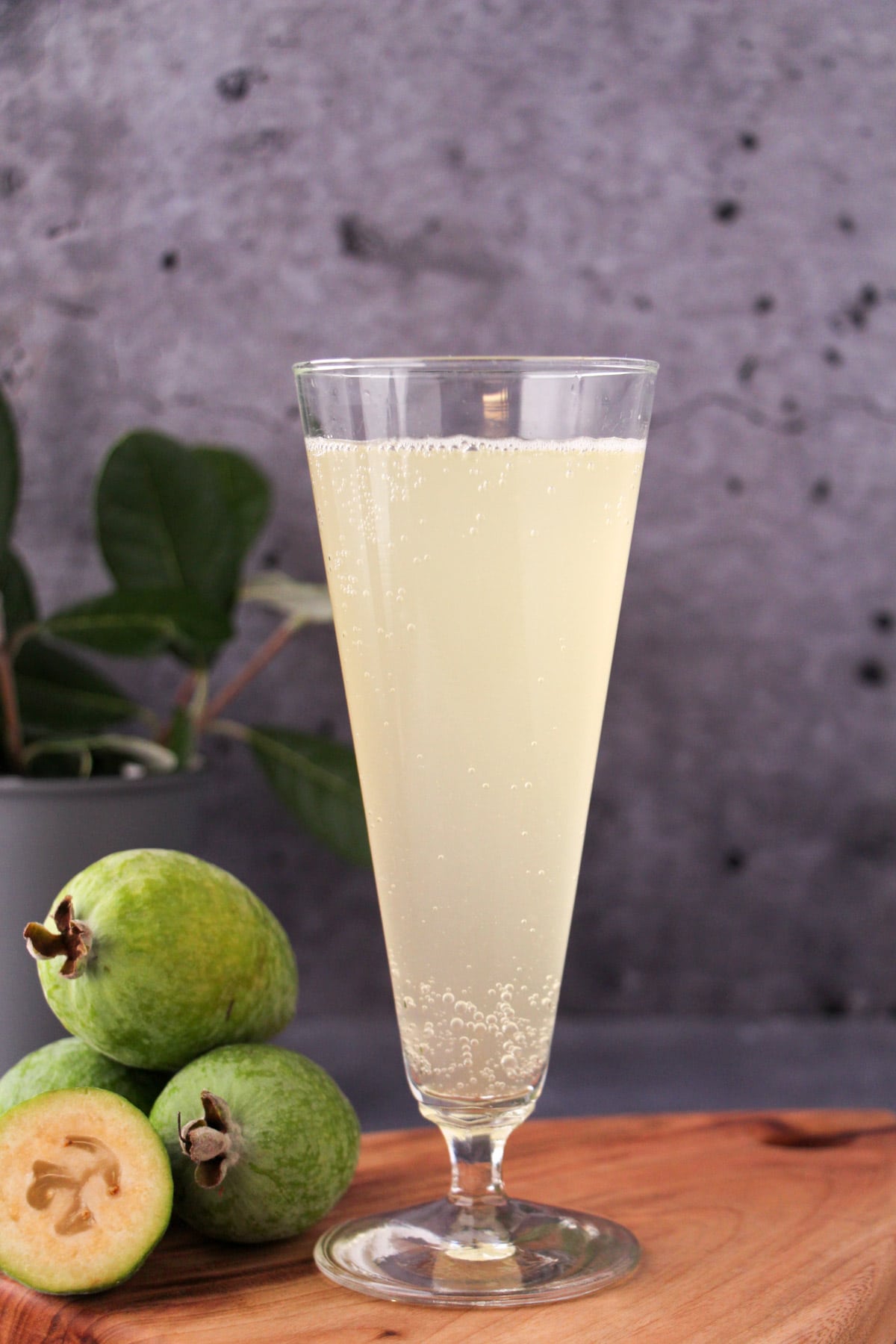


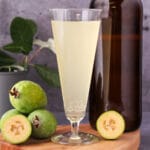
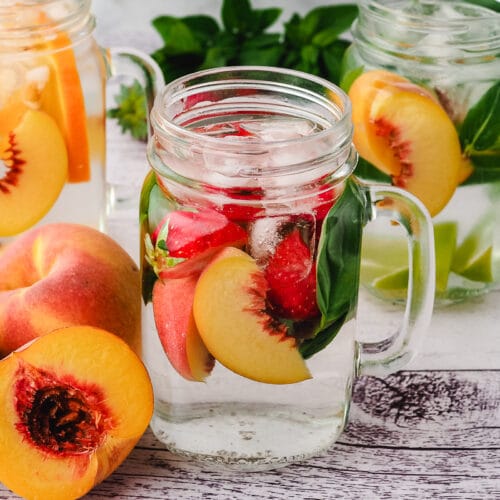


Martina van den Heuvel
Where do you buy cheap feijoa's in Aussie?
Sarah Brooks
Hi Martina, I was able to find some through my local buy, sell, swap group. I was presently surprised by the number of people in my area who have trees. I have seen them on Facebook Market place, or a some fresh fruit and veg markets. I have a planted a couple of trees but they are to small to start producing fruit yet!
Rebecca
You don't need special "wine yeast" bakers yeast will do the same job.
Sarah Brooks
Hi Rebecca,
You can use baker's yeast, but it won't do exactly the same thing.
There's some interesting information here on using baker's yeast vs brewer's yeast when making homebrew: https://www.howtohomebrewbeers.com/2017/09/using-baking-yeast-to-make-home-brew.html#:~:text=You%20can%20totally%20use%20baking,the%20same%20species%2C%20Saccharomyces%20cerevisiae.
You can also leave out the extra yeast all together if you prefer to rely on the natural yeast on the surface of the feijoas 🙂
Georgia
I'm about to start my second ferment and there is some white stuff on the top which I think is mold - any tips for ID?
Thanks!
Sarah Brooks
Hi Georgia, sorry for the last replay, we were away over Easter. If it's just white it might be yeast at the top but it also might be mold. If it's yeast it will be fine to drink however if it's mold there is conflicting advice online about whether homebrew on secondary ferment is safe to drink or not. Mold can produce mycotoxins which can make you sick, simply removing the mold from the top isn't sufficient. The safest thing to do is to throw it out and start again.
There's some interesting formation on mold in cider on this website here you might find helpful: https://pricklycider.com/2020/12/26/mold-the-what-why-and-how-of-it/#:~:text=That%20is%20yeast.,white%20or%20colorless%20(1).